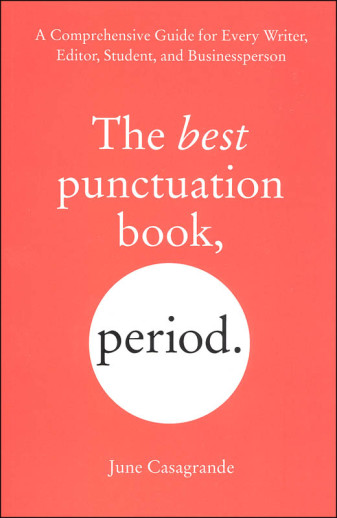We use cookies to make your experience better. To comply with the new e-Privacy directive, we need to ask for your consent to set the cookies. Learn more.
Best Punctuation Book, Period: Comprehensive Guide for Every Writer, Editor, Student, and Businessman
Punctuation is awesome. It can turn a garbled mess of word-vomit into intelligent language, and most of the time, we do this without thinking. In a world without proper punctuation, the elderly would be in constant danger from such casual mistakes as “Lets eat grandma" vs. “Let's eat, grandma." Yet everyone but the most arrogant of Oxford grammarians will agree that it can be pretty darn difficult at times. This approachable, organized, and thoroughly helpful guide is here to diffuse the confusion! Chapters are divided by punctuation symbol, allowing readers to focus exclusively on the most common usage mistakes and exceptions for each. Such heady topics as the Oxford comma, where to put periods in relation to quotations, and when to use hyphens are clarified with ease (if not always with satisfaction). Making this guide the most definitive resource of its kind is the addition of symbols to delineate various styles: book-editing, news media and business writing, scientific, and academic. Appropriate symbols accompany all punctuation rules specific to one style, clearing up almost all lingering questions a writer may have. Finally, the back third of the book contains a master list of commonly punctuated language (such as co-owner and crime fighting) along with their usage symbol, making an excellent on-the-fly reference for tricky words.
Confused about punctuation? There's a reason. Everywhere you turn, publications seem to follow different rules on everything from possessive apostrophes to hyphens to serial commas. Then there are all the gray areas of punctuation"situations the rule books gloss over or never mention at all. At last, help has arrived.
This complete reference guide from grammar columnist June Casagrande covers the basic rules of punctuation plus the finer points not addressed anywhere else, offering clear answers to perplexing questions about semicolons, quotation marks, periods, apostrophes, and more. Better yet, this is the only guide that uses handy icons to show how punctuation rules differ for book, news, academic, and science styles"so you can boldly switch between essays, online newsletters, reports, fiction, and magazine and news articles.
This handbook also features rulings from an expert "Punctuation Panel" so you can see how working pros approach sticky situations. And the second half of the book features an alphabetical master list of commonly punctuated terms worth its weight in gold, combining rulings from the major style guides and showing exactly where they differ. With The Best Punctuation Book, Period, you'll be able to handle any punctuation predicament in a flash"and with aplomb.
These materials focus on mechanics only and do not cover grammar orusage.
| Product Format: | Paperback |
|---|---|
| Brand: | Ten Speed Press |
| Grades: | 7-AD |
| ISBN: | 9781607744931 |
| Length in Inches: | 8.25 |
| Width in Inches: | 5.5 |
| Height in Inches: | 0.625 |
| Weight in Pounds: | 0.45 |

